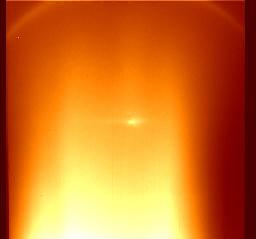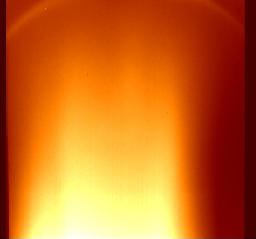ALFOSC grism #16
As of December 2003 we have a new grism available for ALFOSC. The
grism was designed by Michael Andersen and John Telting, with the aim
of doing R=2000 radial velocity studies on compact stars in the blue
part of the spectrum, covering the strong Balmer and Helium lines.
The resolution of the grism is covering the gap between grism #6 and
the Echelle grisms.
The grism was ordered from RGL Spectra-Physics and was glued
in a holder made in the NOT mechanical workshop by Peter Brandt.
Glue: 3M Scotch-Weld 2216.
Design parameters
| Prism glas | PBM2Y |
| Resin | regular |
| Grism straight-through wavelength | 4250 |
| Groove frequency | 1000 |
| Groove angle | 41 |
| Best illumination angle of grating | -10 |
| Prism front angle | -12 |
| Camera focal length | 146.3 |
| Slit width (arcsec) | 0.5 |
| Resolution | 2216 |
| Grism angle | 40.57 |
| Prism index at grism wavelength | 1.64 |
| Resin index at grism wavelength | 1.61 |
| Best prism index | 1.72 |
| Dispersion | 51.21 |
| 0-order angle with horizontal | -36.02 |
| 0-order position on detector | -7090.29 |
| Blaze angle in min order | -1.42 |
| Blaze position on detector | -240.95 |
| Blaze wavelength (nm) | 406.87 |
| Anamorphic magnification | 0.94 |
| Angle of incidence on facet | -6.86 |
A drawing of the grism .
A plot of the grism efficiency.

|
On-sky efficiency
The throughput of the grism was measured using wide-slit standard star
observations. The system efficiency is somewhat lower than for grism
#6 (factor 0.85), but still much better (almost factor 2) than for the
Echelle combinations.
A plot of the efficiency of grism #16 compared with
that of grism #4 . Note that this plot was obtained when the
system efficiency was affected by a 4500 Angstrom dip caused by the
camera optics that needed replacing (for comparison: the measurement
with grism #4 with the old CCD #7 is not affected by the dip).
|
Wavelength coverage and effective resolution
The wavelength coverage is approximately 3500-5060 Angstrom (see
extracted ThAr spectrum). On the left, a 100
second ThAr exposure is shown.
The spectrograph
was focussed in the spectral direction using arclines with Hartmann
masks, the 0.5 arcsec slit and the grism in the beam: the best focus
was found to be approx 1770. Arclines obtained with a slitwidth of
0.5 arcsec are imaged onto approximately 2.4 pixels FWHM giving an
approximate resolution of R=1800. The 0.75 arcsec slit is imaged to
3.3 pixels and the 1.0 arcsec slit to 3.7 pixels. For comparison: the
resolution of grism #6 and the Echelle mode are R=980 and R=4500
respectively (for 0.5 arcsec slit). The dispersion is about 0.8 Angstrom per pixel.
|
Ghost
A small ghost was seen in flatfield images taken with the internal
halogen lamp, and a mask was fitted on the holder of the grism to try
to resolve this problem. The mask makes the grism aperture at the
entrance about 2mm in diameter smaller than the diameter of the grism
(the grisms are sufficiently larger than the beamsize).
 
Internal flatfield without
(left) and with the mask mounted.
Example spectrum
In January 2004 the grism saw first starlight.
An example spectrum showing one of the first science
frames taken with this grism, of an sdB star.
Thanks!
Thanks to Michael, Niels, Roy, Johannes, Pedro, Peter, Thomas, who all
contributed to what is displayed in this report.
cheers,
John
|



